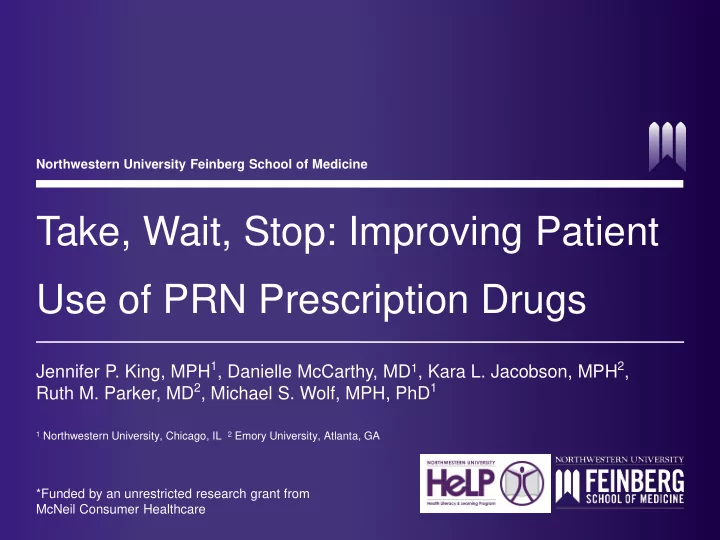

Northwestern University Feinberg School of Medicine Take, Wait, Stop: Improving Patient Use of PRN Prescription Drugs Jennifer P. King, MPH 1 , Danielle McCarthy, MD 1 , Kara L. Jacobson, MPH 2 , Ruth M. Parker, MD 2 , Michael S. Wolf, MPH, PhD 1 1 Northwestern University, Chicago, IL 2 Emory University, Atlanta, GA *Funded by an unrestricted research grant from McNeil Consumer Healthcare
PRN = Pro Re Nata - “As Needed” • Chronic medicines = routine, extended use • PRN = not routine, limit use • Patients are to interpret label instructions & limit use based on symptoms • Studies find that PRN instructions are often misinterpreted * • We focused on prescription pain medicines 2 * Wolf MS, King J, Jacobson K, et al. Risk of Unintentional Overdose with Non- Prescription Acetaminophen Products. J. Gen. Intern. Med. May 26 2012
Developing Patient-Centered Instructions • Deconstruct core actions • Emphasize action terms - Take: Dose (# of pills per use) - Wait: Interval (min. time between doses) - Stop: Maximum daily dose Clearly defined, actionable steps can be envisioned to model a traffic signal. 3
The Labels Commonly Worded Label Take, Wait, Stop Label • Drop ‘exceed’ • Employ carriage returns • Use numeric vs. alpha characters 4
Study Design - Pilot • Study assessing use of Rx acetaminophen- containing pain relievers from ED • Ages 18-80, English speaking, new Rx • Return visit 4-7 days later, 1:1 randomization • Dosing demonstration, socio-demographics & REALM • Errors: Single dose >2 pills, Interval <4hrs, Max >6 pills/24hrs 5
Dosing Activity “Imagine it is 8am & you are having pain. Please show me how many pills you would take at 8am .” “If you were still in pain after taking this dose, when could you take this medicine again ?” “Show me at what time & how many pills you would Dosing tray with 24 boxes, each labeled with an hour of the day. take for your next dose .” 6
Results (n=87) Demographics: • Mean age - 39.8 years • Afr. Amer. – 42%, White – 43%, Other – 16% • Adequate Literacy - 72.4% • No difference in characteristics between label types 7
Results (n=87) Bivariate Outcomes: Label Type Standard Take, Wait, Stop Error Type Total (n=44) (n=43) P value Maximum dose, % 23.0 31.8 14.0 0.05 Single dose, % 1.2 2.3 0.0 0.47 Dose spacing, % 21.8 20.5 23.3 0.75 8
Results, con’t • Relationship between label type and maximum dose errors remained significant • More likely to exceed maximum dose • Standard label – aRR 2.5 (95% CI: 1.05-7.70, p=0.03) • Afr. Amer. – aRR 3.2 (95% CI: 1.11-8.93, p=0.03) • Other – aRR 4.9 (95% CI: 1.57-15.19, p=0.006) 9
Conclusions • “Take, Wait, Stop” label prevented participants from exceeding maximum dose in 24hrs • Patient literacy level - not related to performance • # of pills in single dose ≠ primary source of confusion - strategy did not affect this type of error • Short of specifying times of day to take medicine, difficult to reduce the complexity of dosing interval – strategy didn’t impact spacing 10
Limitations • Pilot – small sample, power • Hypothetical dosing vs. actual • Strength & weakness = taking a PRN analgesic leading up to assessment • Recent pain = more true to life scenario • Dosing based on actual medicine vs. label 11
Implications • Our findings suggest this approach could be a promising direction for improved PRN labeling • Format may be applicable to OTC medicines as majority are PRN. 12
Jennifer King, MPH Health Literacy & Learning Program Feinberg School of Medicine Northwestern University jenniferking@northwestern.edu 312-503-1813 13
Recommend
More recommend